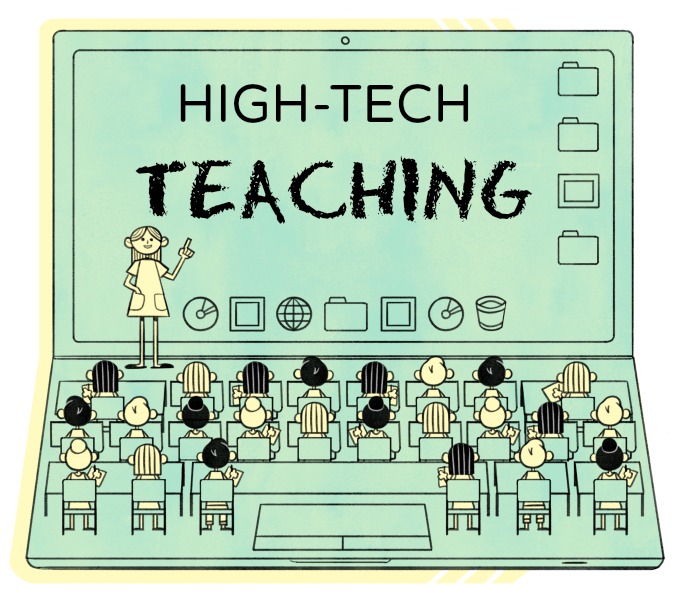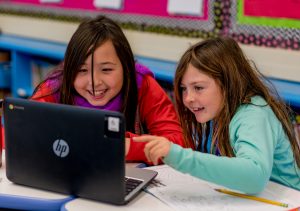Laguna Beach Unified School District is one of the leading digital districts in the state — and it’s taken technology and teamwork to get there.
Integrating technology into the classroom is, undoubtedly, essential to preparing students for college, 21st-century careers and today’s global economy. Against the backdrop of significant advancements and a new set of California Common Core State Standards that require technology use in classrooms, one of the top priorities in Laguna Beach Unified School District (LBUSD) over the last few years has been to ensure that all of its students are ready for the future.

The district upgraded its wireless infrastructure, launched multiple software programs that create engaging virtual learning environments, introduced a Bring Your Own Device (BYOD) initiative and revamped its classrooms. The result is high-speed, interactive learning with cutting-edge technology that rivals that of most college campuses.
This past December, State Superintendent Tom Torlakson declared LBUSD one of the three leading digital districts in California, recognizing not just the increase in technology use but also the improvement and effective leveraging of technology tools to enhance education across the board. LBUSD has proven that incorporating technology not only enriches students’ learning and increases engagement, but it’s also conducive to differentiated instruction and the extension of education outside the four classroom walls. This school year and beyond, local students are set up—in high-tech spaces, of course—for success.
Power Tools
When Michael Morrison, LBUSD’s chief technology officer, took over in 2014, he had his work cut out for him. Back then, roughly 70 percent of classrooms had wireless access points, and classes were sharing computer carts that competed for those connections.
Morrison’s first accomplishment was increasing the network speed by 10 times the previous pace. “We wouldn’t be the best on the instructional side if we didn’t have the best on the technology side, and high-speed Internet provides the foundation for everything else we’ve implemented,” Morrison says.
Much of the funds needed for the upgrade were provided by SchoolPower, a nonprofit that has raised money for Laguna Beach public schools for more than 30 years. The organization’s 2013 Fund-a-Need campaign, aimed at addressing an area of need based on district priorities, raised $150,000 to enhance the wireless infrastructure at all four local schools.
“While SchoolPower invests in other areas like music and the arts, technology has become a recurring focus of our Fund-a-Need [campaign], partly because of the significant impact it has on a large number of students,” says SchoolPower Executive Director Robin Rounaghi.
The high-speed wireless Internet was critical to the district’s next steps, which included rolling out Web-based software programs such as Haiku, Pear Deck and Hapara. These programs not only promote engaging virtual learning environments, but also help students meet one of the cornerstone standards of Common Core—collaboration with others—online.
One program in particular, Haiku, has significantly streamlined online communication and collaboration for faculty, staff and students. Teachers and students can log into and use Haiku from any computer, anytime, which means communication and learning opportunities are constant. It’s also integrated with Google Docs so that notes, discussion boards, comments and questions show up automatically when users make changes. Students can even use Haiku to build and collaborate on small websites called WikiProjects.

“Haiku is where all of our documents are stored, and where teachers can share calendars, lecture notes and assignments, and students can share feedback, questions and work with each other,” Morrison says. “Before, there wasn’t a common tool or language, but now we have something that’s incredibly interactive and easy to use.”
One of the greatest benefits of interactive Web-based software programs like Haiku is the fact that teachers and students can communicate and exchange feedback during the learning process. For example, a teacher can view student essays online and make comments as students are working, from home or in class—not just after they’ve turned in the final product. Plus, students can pose questions and give each other feedback, which in turn continuously informs teachers of where students are in the learning process.
Bring Your Own Device
For students to take advantage of high-speed Internet and interactive Web-based software, however, they need technological devices. In October 2014, LBUSD launched its BYOD initiative, in which students are encouraged to bring their own technology devices to school for classroom use. If a student doesn’t have a device—or chooses not to bring one—he or she has the opportunity starting in fifth grade to check out a Chromebook for the full year. Students are used to having access to such devices: In kindergarten through first grade, there’s a one-to-one ratio of students to iPads available for in-class use, and in second through fourth grades, each student has in-class access to a Chromebook.
Granting students access to their devices in class is just one way that leveraging technology enhances the education experience. Take Pear Deck, for example—an interactive presentation tool that has significantly altered the way teachers communicate with students, and vice versa. Using Pear Deck, teachers can pose questions on the spot with five options for student responses, including multiple choice, text and drawings. Students respond to prompts in class on their own devices, and class participation skyrockets.
“When I ask questions in class now, students are so engaged because everyone has time to stop and think about the answer, and then everyone has something to say,” says Kristin Cowles, a U.S. history teacher with Advanced Placement and traditional classes at Laguna Beach High School (LBHS). “It’s a great way to foster discussion.”
Just as important is the fact that teachers can assess students and get real-time data simply because students are on their devices. Based on responses to a Pear Deck question, a teacher may decide to reteach a lesson, or he or she can create and upload a Google Doc of the questions and answers generated in class for students to use as a study sheet at home. The result is a steady, high-speed stream of learning centered on the student.
Inspiring Spaces
Changes in the Common Core curriculum standards, technology and teaching methods necessitated a change in classroom learning environments as well. In 2014, LBUSD started working on an ambitious initiative called the “4Cs Learning Environments” (4CLEs). These classrooms are conducive to collaboration, creativity, communication and critical thinking—four “Cs” that are part of the Framework for 21st Century Learning developed by national nonprofit P21, which advocates for innovative education.
Teachers tasked with piloting the 4CLE initiative were each given up to 40 hours of research time to analyze the ways in which classroom environments can impact learning. The most important lessons gleaned were those pertaining to classroom setup. “We had to catch up to our virtual space in our physical space, and it has dramatically improved student learning and participation,” Morrison says.

Many teachers with 4CLE classrooms were able to select mobile chairs and tables designed for group work that can be converted into standing desks. They also had a say when it came to setting up their spaces to complement most effectively their teaching. “I was asking my students to collaborate and work together, but then I was constantly battling my classroom,” Cowles says of her pre-4CLE classroom space. “The new learning environments have made working together and classroom management so much easier.”
A 4CLE classroom isn’t just conducive to collaboration—it’s also tech savvy. These innovative learning spaces are equipped with at least two large monitors rather than projectors, which ensure that students can see clearly from wherever they sit. These classrooms also have audio devices for students and teachers. Instructors can listen in on students while they’re working together in pods and speaking into microphones via their tables’ audio systems. An added bonus is the fact that students can better hear teachers when they’re speaking, and teachers need not strain their voices throughout the day.
In order to create more than 30 of these state-of-the-art learning environments throughout the district, substantial funding was necessary. With significant help from an enthusiastic parent, Brent Martini, SchoolPower’s 2015 Fund-a-Need broke records that year with $212,000 raised to outfit 12 4CLE classrooms—six at Thurston Middle School and six at LBHS. These classrooms, completed just in time for the 2015 school year, instantly became more inspiring learning spaces.
Students returning to the district for the start of the 2016/2017 school year will see double the number of technologically advanced classrooms, thanks to another successful SchoolPower fundraiser. The nonprofit’s 2016 Fund-a-Need campaign, The Re-Imagined Classroom (and Library!), aimed at enhancing classrooms at LBHS and Thurston Middle School and transforming the latter’s library, brought in a record-breaking $299,050. The recent round of upgrades signals a promising and continuous trajectory for the district, from which students and teachers alike will benefit in the coming months and years.
“It is rewarding to hear teachers talk about what their new classroom environments mean for what they are able to accomplish with their students,” Rounaghi says.
That is, after all, the end goal. It’s not just about generous funding from SchoolPower, supportive parents, a forward-thinking administration and state-of-the-art software and devices—it’s what LBUSD does with those resources, and how they’re used to help teachers both innovate and teach more effectively.
“In the best way possible, I have completely re-evaluated my teaching, taking advantage of all the tools available to me today to make it the best learning experience for students, which, in the end, is what it’s all about,” Cowles says.
~ Written by Elizabeth Nutt




